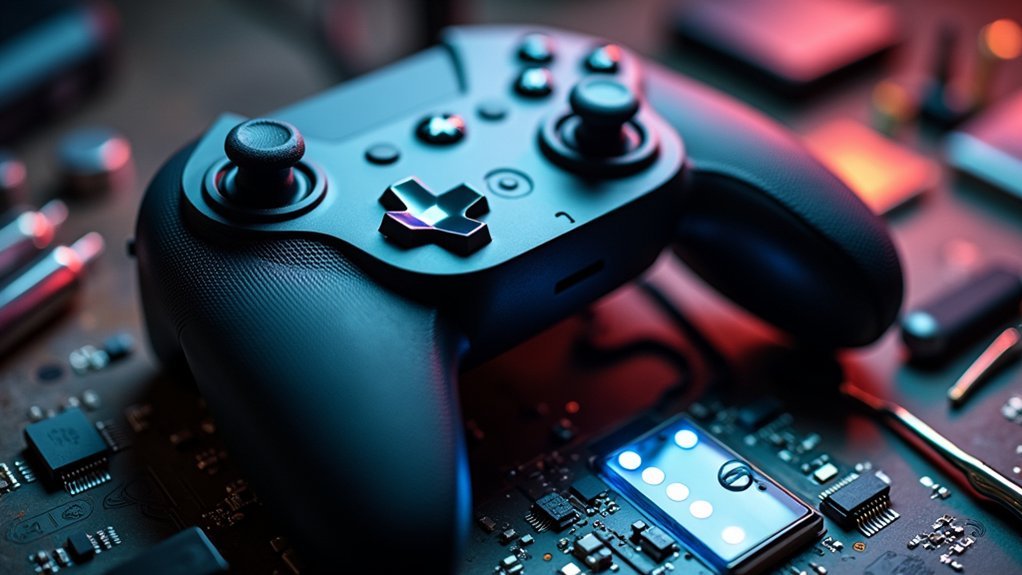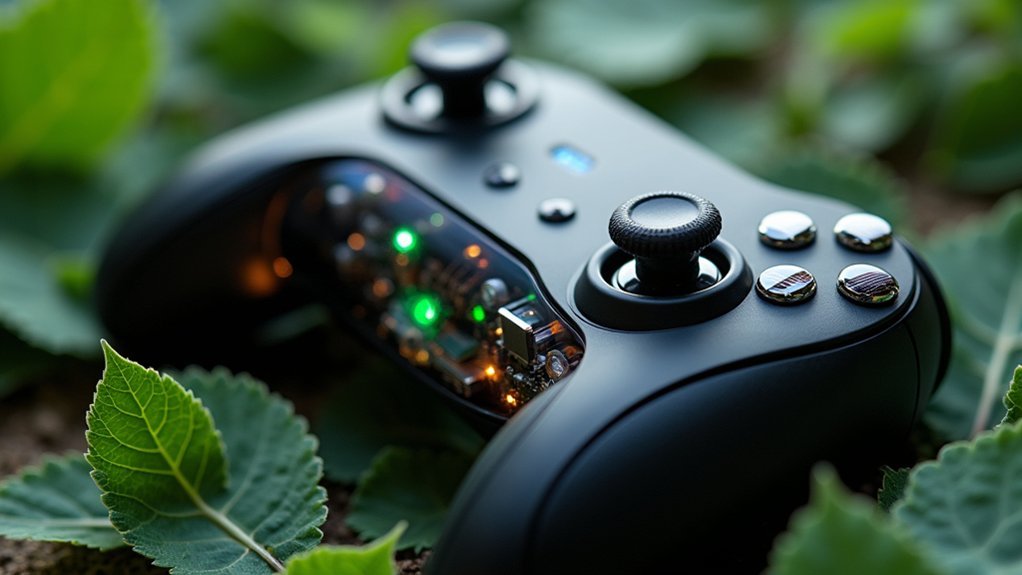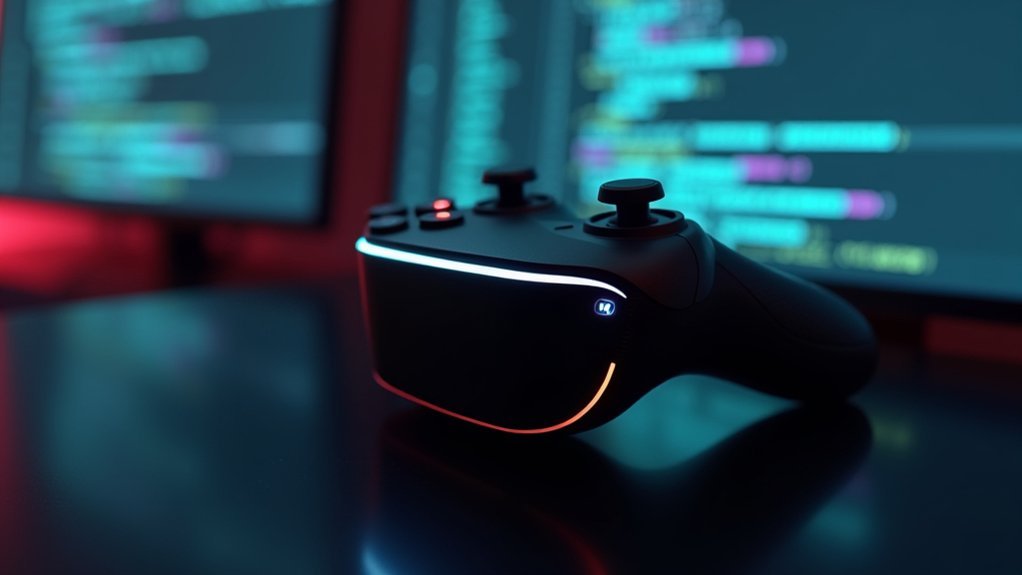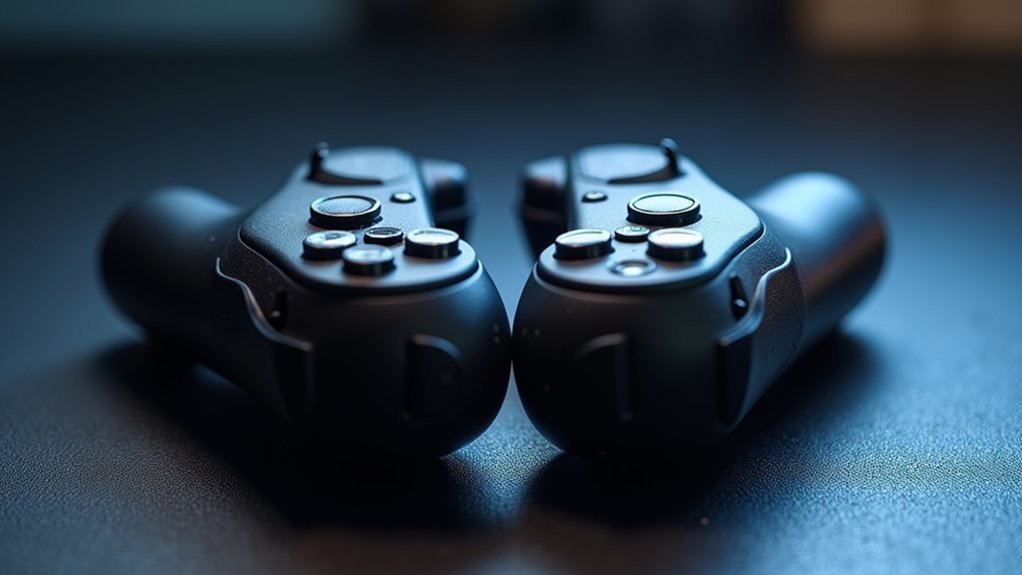You can extend your VR controller’s battery life by choosing models with higher-capacity lithium-ion batteries, enabling smart power management features, and using adaptive sleep modes that reduce energy consumption during idle periods. Charge your controllers with dedicated USB-C cables after each gaming session and avoid deep discharge cycles that can reduce battery performance from the typical 4.5 hours down to just one hour. There’s much more you can optimize for extended gameplay sessions.
Battery Technology and Capacity Considerations

When you’re deep into a VR gaming session, there’s nothing more frustrating than having your controller die mid-game. Your VR controller’s battery life depends heavily on the technology powering it.
Nothing kills the immersion of virtual reality faster than a controller that powers down right in the middle of an epic boss battle.
Most controllers use rechargeable lithium-ion batteries, which typically provide 4.5 to 5 hours of gameplay when new. However, you’ll notice performance degradation over time, with some users reporting battery life dropping to just one hour.
The capacity of these batteries directly affects how long you can play. Manufacturers who invest in higher-capacity batteries give you longer sessions.
Additionally, optimized power management systems make a significant difference in battery longevity. These systems intelligently regulate power consumption, ensuring your controller uses energy efficiently during gameplay while extending overall lifespan through smarter charging protocols.
Power Management Systems and Optimization
Since modern VR controllers consume power continuously through sensors, haptic feedback, and wireless connectivity, smart power management becomes essential for maximizing your gaming sessions.
Effective power management systems can deliver 4.5 to 5 hours of average playtime when properly configured.
You’ll extend battery life considerably by enabling automatic sleep modes when controllers aren’t active. These features prevent unnecessary power drain between gaming sessions.
Regular firmware updates optimize power management systems, improving efficiency and resolving software-related battery issues.
Your charging practices directly impact performance. Use dedicated USB-C cables and avoid leaving controllers idle while plugged in.
Charge after each use and prevent extended periods in discharged states. These optimization habits maintain battery health over time, ensuring consistent performance throughout your controller’s lifespan.
Hardware Design for Energy Conservation

You’ll find that VR controllers built with low power components consume considerably less energy during operation, directly extending your device’s battery life.
When you’re not actively using the controller, adaptive sleep modes automatically reduce power consumption by putting non-essential systems into standby.
These hardware-level energy conservation features work together to minimize the strain on your controller’s battery, reducing charge cycles and preserving long-term battery health.
Low Power Components
While powerful processors might seem essential for responsive VR controllers, energy-efficient components actually deliver the performance you need without draining your battery.
These low power components work smarter, not harder, to extend your gaming sessions considerably.
Energy-efficient processors handle complex calculations while consuming minimal power, giving you responsive controls without constant charging interruptions.
When combined with optimized sensors and lightweight materials, you’ll notice improved tracking accuracy and reduced fatigue during extended play.
Here’s how low power components enhance your VR experience:
- Extended battery life – Play longer without interruption
- Reduced heat generation – Comfortable grip throughout sessions
- Faster response times – Lightweight materials improve tracking precision
- Lower replacement costs – Components last longer with less wear
- Enhanced portability – Lighter controllers reduce arm fatigue
Adaptive Sleep Modes
Although VR controllers can drain batteries quickly during intense gaming sessions, adaptive sleep modes automatically detect when you’re not actively playing and power down non-essential components to preserve energy.
These intelligent systems activate after predetermined inactivity periods, dramatically reducing energy consumption compared to controllers that stay fully powered. Advanced sensors monitor your usage patterns, enabling seamless shifts to low-power states without disrupting your user experience when you resume playing.
You’ll benefit from extended battery life and fewer charging interruptions during longer gaming sessions. The technology also preserves your controller’s battery health over time, potentially extending its overall lifespan.
Manufacturers implementing sophisticated adaptive sleep modes create controllers that require less frequent battery replacements, ultimately improving your satisfaction and reducing long-term maintenance costs.
Tracking Technology Impact on Power Consumption
You’ll notice your VR controller’s battery drains faster when it’s working harder to track your movements with pinpoint accuracy.
The motion sensors inside consume different amounts of power depending on how efficiently they’re designed and calibrated.
You can extend your playtime by understanding how tracking frequency affects power draw and adjusting settings accordingly.
Battery Drain Patterns
When your VR controllers employ sophisticated 6DoF tracking systems, they’re working overtime to monitor precise positional data, which directly translates to higher power consumption than simpler tracking methods.
Understanding these battery drain patterns helps you enhance your VR sessions. Your tracking technology continuously processes motion data, creating distinct power consumption cycles that impact overall battery life.
- Intensive tracking conditions can reduce your VR controllers’ battery life from 4.5 hours to just 1 hour
- Advanced motion tracking combined with haptic feedback creates the highest power consumption scenarios
- Individual gaming habits greatly influence how quickly your batteries deplete during sessions
- USB-C charging between sessions helps maintain optimal battery performance and longevity
- Idle time management reduces unnecessary power drain when controllers aren’t actively being used
Motion Sensor Efficiency
Since different motion sensors operate with varying levels of energy efficiency, your VR controller’s battery performance hinges on the specific tracking technology it employs. Controllers with infrared and optical tracking consume less power during idle states compared to continuous active tracking systems. Your device’s motion sensor efficiency improves markedly when manufacturers integrate low-power accelerometers and gyroscopes for movement detection.
| Tracking Technology | Power Consumption | Battery Life Impact |
|---|---|---|
| Infrared/Optical | Low during idle | Extended usage |
| Continuous Active | High throughout | Reduced duration |
| Accelerometer/Gyro | Minimal detection | Optimized performance |
| Advanced Algorithms | Reduced operations | Enhanced efficiency |
| Energy-Efficient Circuitry | Optimized power | Prolonged sessions |
Improved algorithms enhance tracking accuracy while minimizing power-draining operations. Energy-efficient circuitry guarantees motion sensors don’t excessively impact your controller’s overall power consumption, allowing extended VR sessions.
Tracking Frequency Optimization
Higher tracking frequencies directly impact your VR controller’s power consumption, creating a balancing act between performance and battery longevity.
Tracking frequency refinement guarantees you’ll get the most from your sessions without constantly worrying about dead batteries.
Modern controllers intelligently adjust their tracking updates based on your movement patterns. When you’re actively gaming, they’ll maintain 60-120 Hz for smooth motion capture. During quieter moments, smart algorithms reduce frequency automatically.
- Adaptive algorithms adjust tracking frequency based on your movement intensity
- Power-saving modes kick in during idle periods to conserve energy
- 60-120 Hz range provides peak performance without excessive battery drain
- Firmware updates continuously improve tracking efficiency and power management
- Motion-based scaling increases frequency during fast movements, decreases during slow ones
This intelligent approach maximizes battery life while maintaining responsive gameplay.
Charging Solutions and Battery Maintenance
Most VR controllers deliver between 4.5 to 5 hours of playtime before needing a recharge, making your charging habits essential for long-term battery health.
Smart charging solutions greatly impact your VR controllers’ performance and durability.
You’ll want to charge your controllers immediately after gaming sessions rather than letting batteries fully drain. This practice prevents the deep discharge cycles that damage lithium-ion cells.
Keep separate USB-C cables dedicated to controller charging so you’re never left with depleted batteries.
Consider connecting controllers to phone chargers when they’re idle between sessions. This frequent charging approach maintains ideal battery maintenance and prevents the capacity degradation that occurs with heavy use.
Consistent monitoring of battery levels and proactive charging habits will maximize your controllers’ longevity, ensuring reliable performance throughout extended VR experiences.
Software Updates and Firmware Efficiency

While hardware maintenance keeps your VR controllers physically sound, software updates and firmware efficiency determine how well they’ll perform over time.
Regular updates optimize performance by fixing bugs and improving tracking algorithms, which enhances responsiveness and extends your controllers’ functional lifespan.
Software updates act as digital maintenance, systematically eliminating performance issues while refining tracking precision to maximize your VR controllers’ operational lifespan.
Firmware efficiency directly impacts power consumption, extending battery life and reducing charging frequency.
Updates also improve compatibility with various VR applications, guaranteeing consistent performance that prevents premature degradation.
- Install software updates immediately when manufacturers release them
- Monitor firmware efficiency to maximize battery performance and longevity
- Allow updates to recalibrate tracking algorithms for improved accuracy
- Use updated firmware to identify and correct drifting or jittery movements
- Ascertain compatibility updates are installed before using new VR applications
User Habits That Extend Battery Performance
Beyond keeping your software current, your daily charging and usage patterns greatly impact how long your VR controller batteries will perform at peak levels.
You’ll maximize battery performance by charging controllers during idle periods using separate USB-C cables, which maintains peak function and prevents mid-session power failures.
While you can expect 4.5 to 5 hours of battery life, extended use sessions lasting around 2 hours daily will gradually reduce battery longevity.
Keep your controllers connected to phone chargers when not gaming to guarantee they’re always ready.
Check battery levels regularly and recharge before they drop critically low, as over-discharge damages battery health.
Maintain moderate temperatures during gameplay and charging to protect battery integrity and sustain long-term performance.
Comparing Power Efficiency Across VR Platforms
When examining power consumption across different VR ecosystems, you’ll discover considerable variations in how platforms manage battery life and efficiency.
While typical VR controllers should last 4.5-5 hours, many users experience dramatic drops to just one hour of gameplay. The Meta Quest 3, despite its affordability advantage, struggles with controller battery performance compared to competitors.
Meta Quest 3 controllers fall short of the 4.5-hour standard, often lasting just one hour during gameplay sessions.
Different platforms employ varying battery technologies and power management strategies that directly impact your gaming sessions.
Here’s what affects power efficiency across VR platforms:
- Enhanced tracking technology like 6DoF increases power consumption considerably
- Battery management systems vary drastically between manufacturers
- Controller design choices influence overall energy efficiency
- Platform-specific optimization affects real-world battery life
- Hardware quality impacts long-term durability and performance
Understanding these differences helps you choose VR controllers that’ll support extended gaming sessions.
Frequently Asked Questions
How Long Do VR Controllers Last?
Your VR controllers typically last one to two years with regular use. You’ll get four to five hours of battery life per session, though joystick drift may occur within six months to two years depending on usage.
How Can I Make My VR Headset Last Longer?
You’ll extend your VR headset’s lifespan by cleaning lenses regularly with microfiber cloth, storing it in cool dry places, using recommended charging cables, avoiding unsupported accessories, and promptly updating software.
How Durable Are Quest 2 Controllers?
Quest 2 controllers typically last nearly two years with daily use before you’ll experience joystick drifting issues. They’re moderately durable, but you’ll likely notice battery performance declining over time with regular gaming sessions.
Why Is My Oculus Controller Not Staying On?
Your Oculus controller’s likely shutting off due to low battery levels or poor battery contacts. You’ll need to replace or recharge the batteries, and make certain they’re properly connected. Use high-quality batteries for reliable power.





Leave a Reply